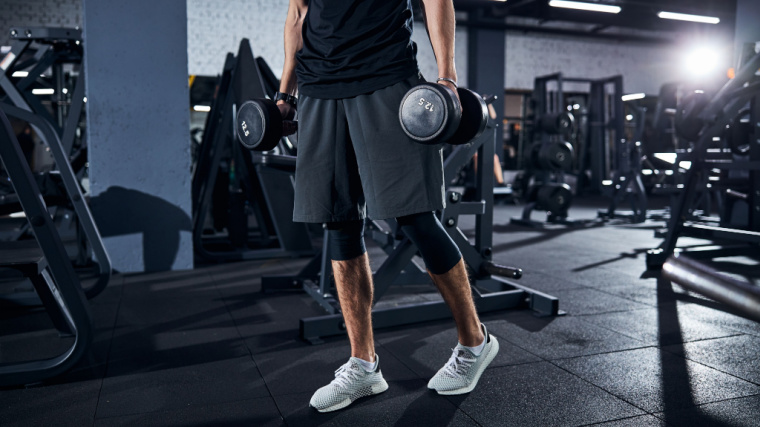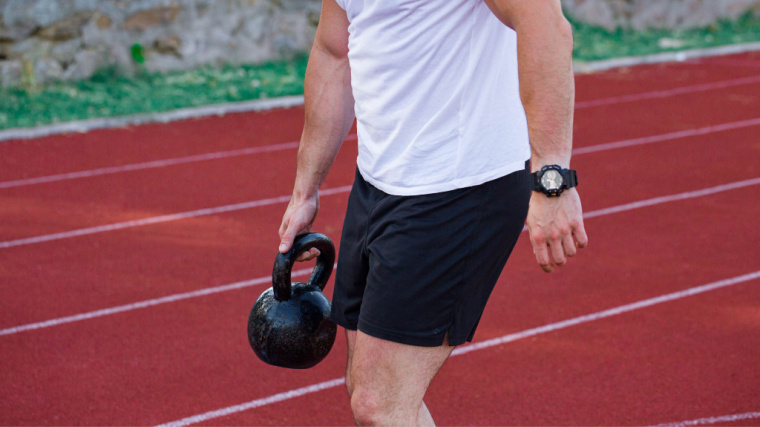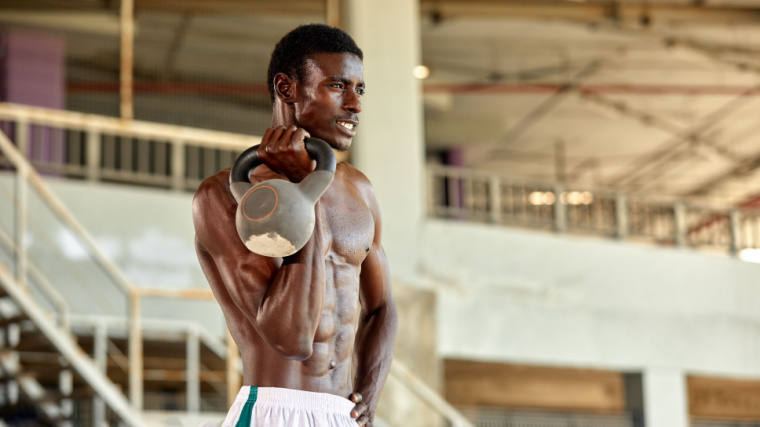Picking up two dumbbells and walking around might not appear to be anything special. It looks too easy. No challenge at all, maybe some cardio and working your grip a little bit. But once you start taking the farmer’s walk seriously, you’ll realize there’s so much more to carrying weights than meets the eye.

Your shoulders, grip, forearms, and lungs soon burn with every step, and any deviations in your walking pattern will be felt twofold while lugging around dumbbells. Besides strengthening your grip to open all the pickle jars, carries can boost your mental toughness, which has a huge carryover to your lifts and daily activities.
As great as the classic farmer’s walk is, there are plenty of effective variations to diversify your game plan. Here are some of the best loaded carry variations, the muscles particularly trained by carrying heavy weights, and the things to watch out for to get the best out of your carries.
Best Loaded Carry Variations
- Offset Carry
- Figure-8 Trap Bar Carry
- Trap Bar Overhead Carry
- Trap Bar Suitcase Carry
- Unilateral Chaos Carry
- Barbell Overhead Carry
- Bottoms-Up Kettlebell Waiter’s Carry
- Bottoms-Up Kettlebell Overhead Carry
- Zercher Carry
- Bear Hug Sandbag Carry
- Plate Pinch Carry
Offset Carry
Offset carries train your body with mismatched weights, requiring your core to work overtime to stabilize your core as you move. Because the load is distributed asymmetrically, your body will want to tilt sideways. The challenge is in not allowing that to happen.
With the offset carry, there is a more significant demand on your core to maintain stability and a neutral spine. The greater difference in the offset, the greater the need for core stability and strength to maintain good posture, even if using the same total load. Holding 60 pounds in one hand and 40 pounds in the other is less challenging than holding 80 pounds in one hand and 20 pounds in the other.
When to Use it
You can program the offset carry at the start of your training session, as part of your warm-up or core work before hitting your main workout. Use can also perform it as a superset and pair it with a press, squat, or any exercise that doesn’t demand too much grip strength. For example performing a landmine press for six to 12 reps, then immediately performing the offset carry for 40 yards per side.
How to Do it
Although you can use dumbbells, kettlebells allow several specific offset carry variations. Hold a heavier load on one side of the body, with your arm hanging straight and your palm facing your leg. Hold a weight roughly 50% lighter in your opposite arm. This can either be locked out overhead or in the “rack position” with your arm bent and your thumb near your shoulder.
With a kettlebell, you can also use a “bottoms-up” position, with your arm bent, elbow pointed forward, and the bottom of the kettlebell aimed at the ceiling. This will require you to squeeze the handle extremely hard to maintain the bell’s vertical position.
Figure-8 Trap Bar Carry
One drawback of any loaded carry is that it requires a lot of space to move and some gyms don’t have 20 or 40 yards of clear space to walk. This is the perfect opportunity to take the trap bar figure-8 carry for a literal spin.
Walking in a figure-8 pattern allows you to get more yards out of a limited space. The trap bar makes turns easier as it places less rotational torque on your lower back than dumbbells do.
When to Use it
The movement brings the opportunity go heavy, as the trap bar allows you to carry more load than dumbbells. Use this carry when training space is limited. Program it at the start of your training when your grip is fresh.
How to Do it
Stand in the center of the trap bar, hinge at your hips and slightly bend your legs to grab the handles. Keep a neutral spine and brace your core as you deadlift weight to a standing position. Walk in a figure-8 pattern — go forward for several steps, turn slowly to one side, continue forward, turn slowly to the other side, and repeat.
Resist the urge to hurry. Walking at a controlled, deliberate pace will make your turns easier and safer, and it extends your time under tension. Keep your shoulders down and your chest up. When you’re finished walking for distance or total time, stabilize the weight before lowering it with control.
Trap Bar Overhead Carry
The overhead carry can be great for shoulder health and upper body strength, but not everyone can carry a barbell locked out overhead due to wrist or elbow issues. Enter the trap bar with the neutral handles to put your joints in a more user-friendly position.
Setting the trap bar in a squat rack at shoulder-height works best. With the weight overhead, watch every step you take due to total-body demand and instability.
When to Use it
Use the trap bar overhead carry if you have any wrist or elbow pain when supporting a barbell in the overhead position. Overhead carries are especially demanding of your upper back and shoulder stabilizers, so the movement is best trained early in your workout before those support muscles are fatigued from other exercises.
How to Do it
Set up the trap bar in a squat rack at shoulder-height with the handles pointed down. Step inside the trap bar, facing the direction you are walking. Perform an overhead press and hold the locked out position. Walk slowly straight ahead for a set distance or time. Stand still and carefully turn around before walking back into the squat rack. Lower the weight to the pins and rest.
Trap Bar Suitcase Carry
The suitcase carry is single-arm farmer’s walk, performed with the load in one arm hanging at your side. The offset load is an way to strengthen your lateral core (abdominals and obliques) while building your grip.
The trap bar suitcase carry takes this movement up a notch as the weight is more off-center, forcing your obliques to work harder. You can also potentially use more weight on a trap bar than any dumbbell variation to further your strength gains.
When to Use it
The trap bar suitcase carry works well to emphasize your oblique muscles and stabilizers on the sides of your core. This is another variation to plug in when you want to challenge yourself with heavier loads, or when your available dumbbells only go so high. Perform the exercise as part of your warm-up or early on in your training before grip strength and core stability are exhausted from other movements.
How to Do it
Stand the trap bar on its side and load plates on both ends. Grab the center of the bar, and with your shoulder down, chest up, and shoulders level, and walk slowly with good posture. Once you have gone your programmed distance, put the trap bar down and rest it on the side of your leg. Then hold it with one hand as you turn around. Swap sides and repeat.
Unilateral Chaos Carry
Adding a band around the handle of kettlebell or through the center of a weight plate creates tremendous instability because of the oscillations or “micro-bounces” created with each step. This will light up your core, grip, and shoulder stabilizers.
Gripping the band places unique demands on your grip strength because it’s tough to hold on to. The single-sided load will also increase the challenge to your oblique muscles.
When to Use it
If you have access to resistance bands, this is an excellent variation to incorporate. It’s ideal for focusing on shoulder stabilizer strength and rotator cuff health. You can do this as part of your warm-up or pair it with an exercise during your workout that doesn’t require too much grip strength, like a squat or a press variation.
How to Do it
Wrap a heavy looped band around the kettlebell handle (sometimes called the “horn”) or slide it through the center hole of a weight plate. Holding the band closer to the load makes this exercise easier because there will be less room to bounce. Sliding your hand farther from the weight will increase the difficulty. Keep your shoulder down away from your ear and your chest up. Don’t let your shoulders tilt to compensate for the weight. Walk for distance or time, place the weight down, and then repeat with the opposite hand.
Barbell Overhead Carry
The barbell overhead carry puts your whole body under tension. Every step will test your single-leg balance, strength, concentration, and mental toughness. It also might be one of the most eye-catching movements you can do.
Because the weight is so far from your center of gravity, a little goes a long way. Start on the lighter side, somewhere around 60% of your barbell overhead press one-repetition maximum. This also makes it less difficult to get the weight into position, so you can focus on holding the lockout as you walk.
When to Use it
This is one of the most challenging loaded carry variations because it works every muscle from head to toe and requires laser-like focus. Perform this early in your training before fatiguing any muscles, after your general warm-up and before your main workout.
How to Do it
Set up the barbell in a squat rack near head-height. A wider-than-shoulder-width grip works well for most people, but adjust to your individual arm length and mobility. Press the barbell overhead and ensure your wrists are neutral, elbows are locked out, and your biceps are even or behind your ears. Walk slowly and with total control. Pause and carefully rotate to return the barbell to the squat rack.
Bottoms-Up Kettlebell Waiter’s Carry
The instability of holding a kettlebell “bottoms-up” forces you to squeeze the squeeze the daylights out of the kettlebell’s handle to maintain its inverted position. This does wonders for your grip strength and carries over to increased recruitment of your shoulder stabilizers. (1)
The bottoms-up kettlebell waiter’s carry helps to build your rotator cuff, shoulder stability, and lateral core strength. Your forearm and grip muscles are also called into action non-stop, so don’t be surprised if your grip burns out before your abs or shoulders.
When to Use it
If you’re coming back from a shoulder injury or if you lack the shoulder mobility needed to maintain an overhead carry, this is a great exercise to strengthen your shoulders, rotator cuff, and upper back. If you dislike side planks, this is a good alternative to work your obliques without laying still for 60 boring seconds.
How to Do it
Grip one kettlebell and bring it to shoulder-height with your thumb toward your face and the bell pointed to the ceiling. Bend your elbow and create a roughly 90-degree angle from your forearm through your elbow to your shoulder. Make sure your wrist is neutral and the kettlebell’s handle sits centered in the meat of your hand. With good upright posture, walk straight ahead, swap hands, and repeat.
Bottoms-Up Kettlebell Overhead Carry
This is a more challenging progression of the bottoms-up waiter’s carry. You’ll get increased intensity with a reduced load because of the extra muscular tension needed to hold the bottoms-up KB overhead.
Because the load is farther from your center of gravity, it’s much harder to balance the weight with each step. Your core, shoulder, and arm will be highly activated for the entire set.
When to Use it
When you feel comfortable with the bottoms-up waiter’s carry, use the same load and progress to this alternative. It’s an efficient way to train your upper back, shoulders, and core, with an emphasis on the obliques and shoulder stabilizers.
How to Do it
Grip a kettlebell firmly with the bottom of the bell facing the ceiling. Use a neutral-grip with your thumb toward your face, and press the weight overhead while maintaining the bottoms-up position. Keep your wrist neutral and your pinky facing forward. Walk with the weight locked out overhead. After a set distance or time, lower the weight, switch hands, and repeat.
Zercher Carry
The front-loaded position of the Zercher carry challenges your upper back, core, arms, and legs while dealing with holding the weight in the crooks of your elbows. This helps build some mental toughness, total-body conditioning, and rock-solid anterior core (abdominal and hip) strength.
If you want to improve your ability to deal with physical and mental discomfort, this exercise is for you. However, if supporting a barbell in the crook of your arms is too much, the movement can be performed with an EZ-bar or even a sandbag or duffel bag filled with random objects for heft.
When to Use it
The Zercher carry is tough, no doubt about it. It works well as part of a conditioning circuit to improve fat loss or as a standalone session for mental toughness.
How to Do it
Set up a loaded barbell around hip-height in the squat rack. Squat down and cradle the barbell in the crooks of your elbows with your palms facing you. Clasp your hands together for added strength and stability, pull your shoulders back, and stand up without rounding your back. Avoiding shrugging your shoulders up as you walk. Pause after a set distance or time, turn around, and return to the squat rack. Try not to collapse when the set is done.
Bear Hug Sandbag Carry
When most people think of loaded carries, they think of fairly traditional exercises using balanced and symmetrical implements that give you convenient handles to hold. But how often does that perfect scenario happen outside of the gym? Not often, and that’s why it pays to get a bit awkward with asymmetrical loads like the sandbag carry. (2)
By manipulating unevenly distributed weight, like a floppy sandbag, your body is challenged to recruit a variety of stabilizers in most joints including your ankles, hips, and shoulders.
When to Use it
Whenever you have access to a sandbag, this exercise is great to include as part of a conditioning or fat-loss circuit. It can also be performed as a finisher, for either time or distance, at the end of your training.
How to Do it
Place the sandbag on a flat bench, or leave it on the floor for even more lower body work. Squat down and slide your hands under the bag to set your grip. Pull the bag close to your body as you stand upright. Hug the bag to your torso and stabilize your upper body. Walk upright, maintaining total body tension for safety and effectiveness. Keep the bag close to your body as you walk. Don’t allow the weight to pull your upper body out of alignment as your arms and shoulders fatigue.
Plate Pinch Carry
The plate pinch tests your “pinch grip” strength, which is different from “support grip” (trained in movements like the suitcase carry) or “crushing grip” (trained with bottoms-up movements). The pinch grip specifically strengthens your fingers and thumbs, as well as your forearms.
This is an excellent exercise for football players, rugby players, and combat sports athletes to improve sport-specific grip strength. Stronger hands and fingers will also carry over to boost any pulling exercises, making your grip less of a weak link.
When to Use it
This movement is best trained at the end of your workout because you don’t want to exhaust your finger strength before other exercise, which will interfere with your strength work. Pairing it with a biceps exercise will give your forearms a nice pump.
How to Do it
In each hand, grab a weight plate by the outer ring using just your fingertips and thumb, not “sinking” your entire hand onto the weight. Pull your chest up and set your shoulders down to maintain good posture. Walk straight ahead, paying careful attention to your finger fatigue as you walk. Be careful not to unexpectedly drop the weight on your feet.
Muscles Worked by Carries
Most carry variations work similar muscles, but certain variations can emphasize your upper back, or core strength, shoulder stability, or more. Generally, loaded carries and their variations train the muscles of your back, core, and arms.
Forearms
Any time you pick up a weight, your forearm flexors (on the bottom of your forearm) and extensors (on the top side) co-contract to grip and to keep your wrists in a neutral position.

Your forearm muscles will be more heavily recruited in movements that keep your arms down by your side and relatively less recruited in overhead movements.
Upper Back
Keeping your shoulders down and your chest up while walking with a load will put your upper back to work overtime. The upper back is composed of several muscles including the trapezius, rhomboids, and rear deltoids (shoulders). These muscles work together to control your shoulder blades, which are held in a static contraction during any walking exercise.
Rotator Cuff
Your small rotator cuff muscles are engaged when you grip anything in your hands. Its primary role is, essentially, to keep your upper arm in its socket. Loaded carries will attempt to push or pull your arm out of position, and the rotator cuff is required to constantly fight to maintain a strong, stable position.
Deltoids
You shoulder muscles (deltoids), along with your rotator cuff, work isometrically to give your shoulders the stability it needs to carry heavy things. Supporting a locked out position overhead or holding your arms in front of your body (as in the sandbag bear hug or Zercher carry) will increase recruitment of the shoulders, specifically the anterior (front) head.
The lateral and posterior heads (side and rear) are more significantly recruited during overhead or “arms-at-your-side” carries.
Core
Your core muscle — the abdominals, obliques, and lower back — work isometrically to keep your spine neutral and to maintain good posture while carrying things. A stronger core can help to reduce your overall risk of injury.(3) Any exercise emphasizing a single-side of the body (like the offset carry) will drastically increase the challenge to your core muscles.
Glutes
When you’re carrying a load, every single step you take will engage your glutes to keep you balanced and to propel you forward through a little thing called hip extension. Hip extension is what drives your leg back behind your body (and, at the same time, pulls your body forward in motion), and it’s a key function of the glutes.
Interestingly, the glutes have been shown to be more heavily recruited in single-arm carries, like the suitcase carry, compared to front-loaded carries like the Zercher carry. (4)
Carry Form Tips
Although you “can” carry some things with less than optimal posture — the sandbag bear hug can be tricky here— it’s more efficient and safer if you don’t let your posture slip. To get all the benefits of carries, it’s best to walk under load with good posture. Keep your shoulders punched back and pulled down away from your ears, keep your chest up, and aim to keep your shoulders and hips level without being pulled sideways.

When you’re new to performing loaded carries, start with the by-your-side variety like the suitcase carry or even the plate pinch carry. The further away the load is from your body’s center, like any overhead carry, the more stability and balance demands increase. If you lack the shoulder mobility to press overhead, stick to carries with a lower arm position while working on your shoulder mobility.
Although increasing the load you carry is often the name of the game, it pays to vary your load and distance depending on your specific goals. If you’re after fat loss or improved conditioning, reduce the weight, shorten the rest period between sets, and increase the total distance. If your goal is strength, increase the load and decrease the distance to shift focus.
Carry Away For Gains
Loaded carries are some of the biggest bang for your buck exercises. They can have a huge carryover to your lifts inside the gym and the activities of daily living because they strengthen key muscle groups in your legs, hips, abs, and shoulders. They can improve your strength, mental toughness, posture, and balance. All you have to do is pick up a weight and walk. Work your way though these variations and you’ll soon find out they sound simple, but they’re far from easy.
References
-
Gontijo, L. B., Pereira, P. D., Neves, C. D., Santos, A. P., Machado, D., & Bastos, V. H. (2012). Evaluation of strength and irradiated movement pattern resulting from trunk motions of the proprioceptive neuromuscular facilitation. Rehabilitation research and practice, 2012, 281937. https://doi.org/10.1155/2012/281937
- Sell, Katie PhD, CSCS1; Taveras, Kurt BS2; Ghigiarelli, Jamie PhD, CSCS1. Sandbag Training: A Sample 4-Week Training Program. Strength and Conditioning Journal: August 2011 – Volume 33 – Issue 4 – p 88-96 doi: 10.1519/SSC.0b013e318216b587
-
Huxel Bliven, K. C., & Anderson, B. E. (2013). Core stability training for injury prevention. Sports health, 5(6), 514–522. https://doi.org/10.1177/1941738113481200
-
Neumann, D. A., & Cook, T. M. (1985). Effect of load and carrying position on the electromyographic activity of the gluteus medius muscle during walking. Physical therapy, 65(3), 305–311. https://doi.org/10.1093/ptj/65.3.305
Featured Image: lunamarina / Shutterstock






